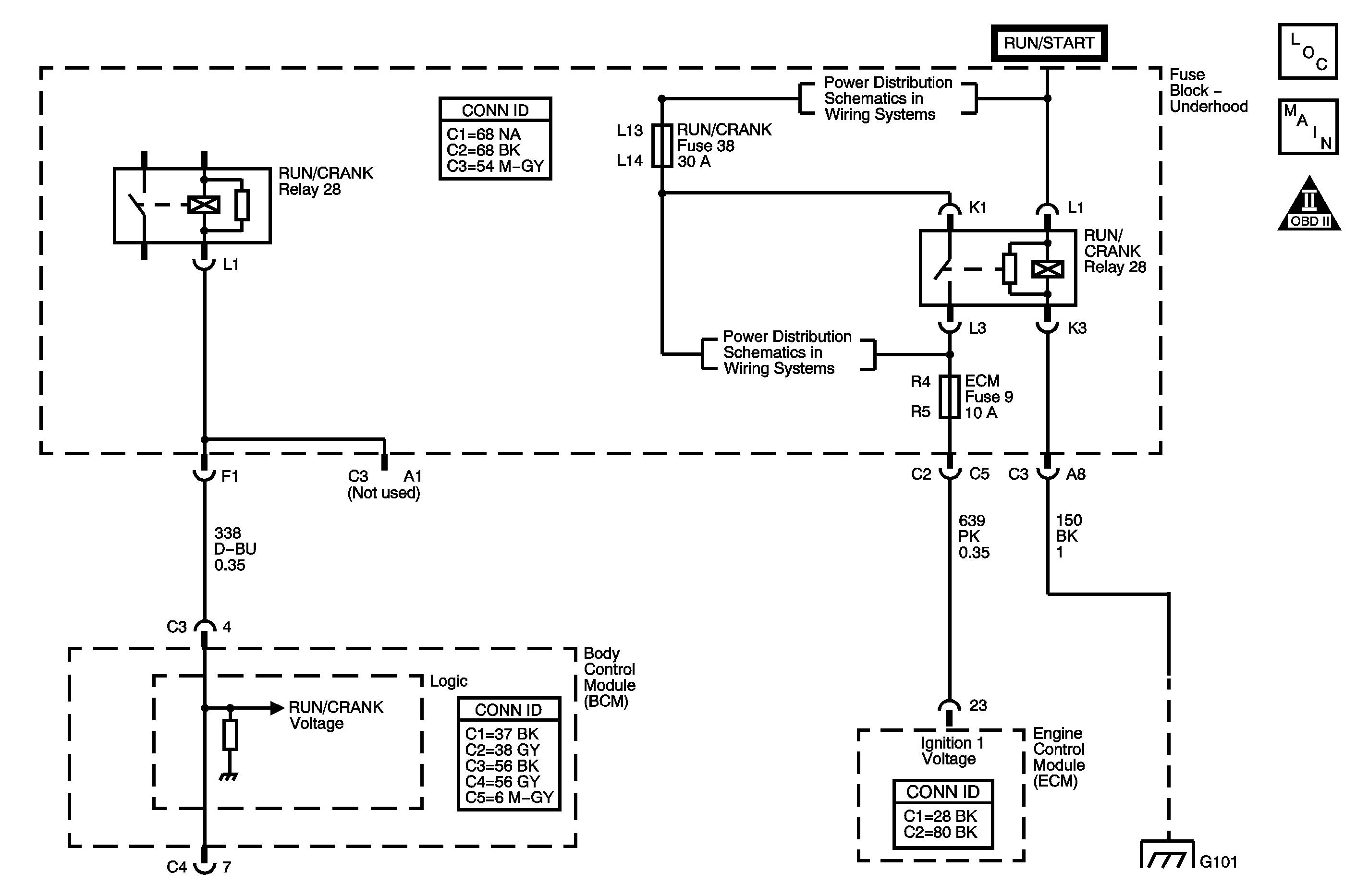
Circuit Description
The engine control module (ECM) receives the ignition 1 signal with the ignition ON. The ECM receives this signal through the ignition 1 voltage circuit from the RUN/CRANK relay. The RUN/CRANK relay is controlled by the body control module (BCM). The RUN/CRANK relay supplies power to several components when in the RUN or CRANK power mode. If the ECM detects an improper ignition 1 voltage signal, DTC P2533 will set.
Conditions for Running the DTC
The ignition is ON.
Conditions for Setting the DTC
| • | The ECM detects an improper ignition 1 voltage input in the CRANK power mode. |
| • | The condition exists for more than 3 seconds. |
Action Taken When the DTC Sets
| • | The ECM will not illuminate the malfunction indicator lamp (MIL). |
| • | The ECM will store conditions which were present when the DTC set as Fail Records only. |
Conditions for Clearing the DTC
| • | The history DTC will clear after 40 consecutive warm-up cycles have occurred without a malfunction. |
| • | The DTC can be cleared by using the scan tool Clear DTC Information function. |
Step | Action | Yes | No |
|---|---|---|---|
Schematic Reference: Engine Controls Schematics Connector End View Reference: Engine Control Module Connector End Views or Engine Controls Connector End Views | |||
1 | Did you perform the Diagnostic System Check-Engine Controls ? | Go to Step 2 | |
2 | Turn the ignition switch to the CRANK position. Does the engine crank? | Go to Step 3 | Go to Step 4 |
3 |
Does the test lamp illuminate on both sides of the ECM fuse? | Go to Step 6 | Go to Step 9 |
4 |
Does the test lamp illuminate on both sides of the RUN/CRANK fuse? | Go to Step 5 | Go to Step 11 |
5 |
Does the engine start and run? | Go to Step 7 | Go to Step 12 |
6 |
Does the test lamp illuminate? | Go to Step 17 | Go to Step 10 |
7 |
Does the test lamp illuminate? | Go to Step 15 | Go to Step 8 |
8 | Connect a test lamp between the run/crank voltage circuit at the RUN/CRANK relay connector and a good ground. Does the test lamp illuminate? | Go to Step 13 | Go to Step 14 |
9 |
Did you find and correct the condition? | Go to Step 21 | Go to Step 17 |
10 | Test the ignition 1 voltage circuit for an open and for a high resistance. Refer to Circuit Testing and Connector Repairs in Wiring Systems. Did you find and correct the condition? | Go to Step 21 | Go to Step 17 |
11 |
Is the repair complete? | Go to Step 21 | -- |
12 | Repair the open on the battery voltage circuit between the RUN/CRANK fuse and the ECM fuse. Refer to Circuit Testing and Connector Repairs in Wiring Systems. Is the repair complete? | Go to Step 21 | -- |
13 | Repair the open on the RUN/CRANK relay ground circuit. Refer to Circuit Testing and Connector Repairs in Wiring Systems. Is the repair complete? | Go to Step 21 | |
14 | Test the run/crank voltage circuit between the relay and the body control module (BCM) for an open and for a short to ground. Refer to Circuit Testing and Connector Repairs in Wiring Systems. Did you find and correct the condition? | Go to Step 21 | Go to Step 16 |
15 | Test for an intermittent and for a poor connection at the RUN/CRANK relay. Refer to Testing for Intermittent Conditions and Poor Connections and Circuit Testing in Wiring Systems. Did you find and correct the condition? | Go to Step 21 | Go to Step 18 |
16 | Test for an intermittent and for a poor connection at the BCM. Refer to Testing for Intermittent Conditions and Poor Connections and Circuit Testing in Wiring Systems. Did you find and correct the condition? | Go to Step 21 | Go to Step 19 |
17 | Test for an intermittent and for a poor connection at the ECM. Refer to Testing for Intermittent Conditions and Poor Connections and Circuit Testing in Wiring Systems. Did you find and correct the condition? | Go to Step 21 | Go to Step 20 |
18 | Replace the RUN/CRANK relay. Refer to Relay Replacement in Wiring Systems. Did you complete the replacement? | Go to Step 21 | -- |
19 | Replace the BCM. Refer to Body Control Module Replacement in Body Control System. Did you complete the replacement? | Go to Step 21 | -- |
20 | Replace the ECM. Refer to Engine Control Module Replacement . Did you complete the replacement? | Go to Step 21 | -- |
21 |
Does the DTC fail this ignition? | Go to Step 2 | Go to Step 22 |
22 | Observe the Capture Info with a scan tool. Are there any DTCs that have not been diagnosed? | System OK | |
